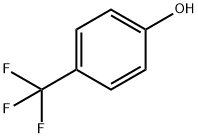4-(Trifluoromethyl)phenylacetic acid
Synonym(s):(α,α,α-Trifluoro-p-tolyl)acetic acid
- CAS NO.:32857-62-8
- Empirical Formula: C9H7F3O2
- Molecular Weight: 204.15
- MDL number: MFCD00004352
- EINECS: 251-263-5
- SAFETY DATA SHEET (SDS)
- Update Date: 2025-01-27 09:38:02

What is 4-(Trifluoromethyl)phenylacetic acid?
Chemical properties
white to very pale yellow crystals or
The Uses of 4-(Trifluoromethyl)phenylacetic acid
4-(Trifluoromethyl)benzeneacetic Acid is an intermediate used to synthesize PPARγ/δ dual agonists via solid-Phase parallel synthesis. It was also used to prepare heterocyclic xanthine derivatives as highly potent and selective human A2B adenosine receptor antagonists.
General Description
4-(Trifluoromethyl)phenylacetic acid undergoes diolefination mediated by mono-N-protected amino acid ligands in the presence of ethyl acrylate, Pd(OAc)2, KHCO3 and t-amyl alcohol.
Properties of 4-(Trifluoromethyl)phenylacetic acid
| Melting point: | 82-85 °C(lit.) |
| Boiling point: | 203°C (rough estimate) |
| Density | 1.2815 (estimate) |
| storage temp. | Sealed in dry,Room Temperature |
| form | Crystals or Crystalline Powder |
| pka | 4.01±0.10(Predicted) |
| color | White to very pale yellow |
| BRN | 2267687 |
| CAS DataBase Reference | 32857-62-8(CAS DataBase Reference) |
| NIST Chemistry Reference | («ALPHA»,«alpha»,«alpha»-trifluoro-p-tolyl)-acetic acid(32857-62-8) |
Safety information for 4-(Trifluoromethyl)phenylacetic acid
| Signal word | Warning |
| Pictogram(s) |
 Exclamation Mark Irritant GHS07 |
| GHS Hazard Statements |
H315:Skin corrosion/irritation H319:Serious eye damage/eye irritation H335:Specific target organ toxicity, single exposure;Respiratory tract irritation |
| Precautionary Statement Codes |
P261:Avoid breathing dust/fume/gas/mist/vapours/spray. P264:Wash hands thoroughly after handling. P264:Wash skin thouroughly after handling. P271:Use only outdoors or in a well-ventilated area. P280:Wear protective gloves/protective clothing/eye protection/face protection. P302+P352:IF ON SKIN: wash with plenty of soap and water. P305+P351+P338:IF IN EYES: Rinse cautiously with water for several minutes. Remove contact lenses, if present and easy to do. Continuerinsing. |
Computed Descriptors for 4-(Trifluoromethyl)phenylacetic acid
New Products
Indole Methyl Resin tert-butyl 9-methoxy-3-azaspiro[5.5]undecane-3-carboxylate Boc-His(Boc)-OH 2-CTC Resin 4-Chloro-7-tosy1-7Hpyrrolo[2,3-d]pyrimidine 5,7-Dibromo-1H-indole 2,5-dichloro-N-hydroxy-4,6-dimethylpyridine-3-carboximidamide 2,2-Dimethoxy-7-azaspiro[3.5]nonane hydrochloride 4-chloromethyl-5-methyl-1,3-dioxol-2-one (DMDO-Cl) R-2-BENZYLOXY PROPIONIC ACID 1,1’-CARBONYLDIIMIDAZOLE 1,1’-CARBONYLDI (1,2-4 TRIAZOLE) N-METHYL INDAZOLE-3-CARBOXYLIC ACID 4-((2-hydroxyethyl)thio)benzoic acid 1-(TERT-BUTOXYCARBONYL)-2-PYRROLIDINONE Methyl 6-methylnicotinate 3-Pyridineacrylic acid tert-Butyl carbazate TETRAHYDRO-2H-PYRAN-3-OL 2-((4-morpholinophenylamino) (methylthio) methylene) malononitrile 3-(4-morpholinophenylamino)-5-amino-1H-pyrazole-4-carbonitrile 2,4-dihydroxybenzaldehyde 1,3-Diethyl-1,3-Diphenylurea Methyl 2-methylquinoline-6-carboxylateRelated products of tetrahydrofuran








You may like
-
 32857-62-8 4-(TRI FLURO METHYL)PHENYL ACETIC ACID 98%View Details
32857-62-8 4-(TRI FLURO METHYL)PHENYL ACETIC ACID 98%View Details
32857-62-8 -
 4-(Trifluoromethyl)phenylacetic Acid CAS 32857-62-8View Details
4-(Trifluoromethyl)phenylacetic Acid CAS 32857-62-8View Details
32857-62-8 -
 Pyridine 99.5% HPLC /UV SpectroscopyView Details
Pyridine 99.5% HPLC /UV SpectroscopyView Details
110-86-1 -
 Piperazine Spot supply, best priceView Details
Piperazine Spot supply, best priceView Details
110-85-0 -
 Dibutyl PhthalateView Details
Dibutyl PhthalateView Details
84-74-2 -
 Imidazole Spot supply, competitive priceView Details
Imidazole Spot supply, competitive priceView Details
288-32-4 -
 Octadecyl 3-(3,5-di-tert-butyl-4-hydroxyphenyl)propionate 98% (GC)View Details
Octadecyl 3-(3,5-di-tert-butyl-4-hydroxyphenyl)propionate 98% (GC)View Details
2082-79-3 -
 Thiourea 99% ARView Details
Thiourea 99% ARView Details
62-56-6
Statement: All products displayed on this website are only used for non medical purposes such as industrial applications or scientific research, and cannot be used for clinical diagnosis or treatment of humans or animals. They are not medicinal or edible.
